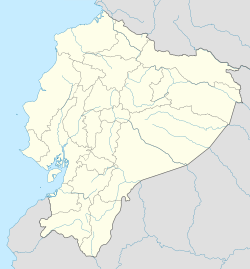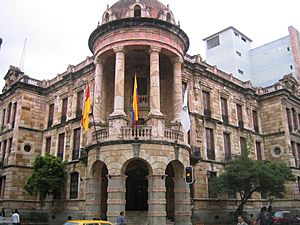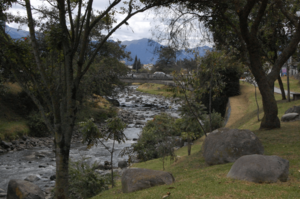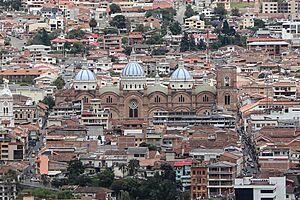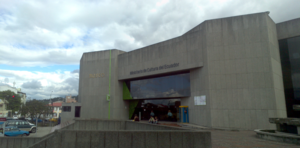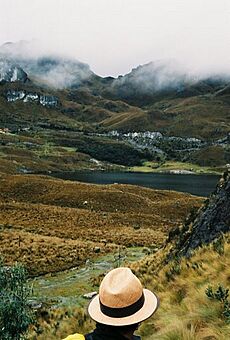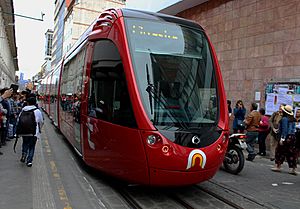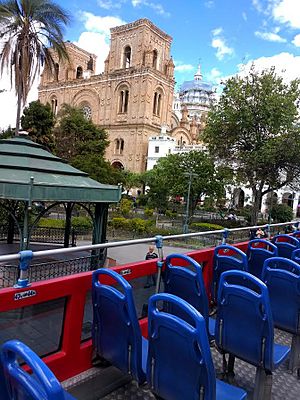Cuenca, Ecuador facts for kids
Quick facts for kids
Cuenca
|
|||
|---|---|---|---|
|
City
|
|||
| Santa Ana de los Ríos de Cuenca | |||
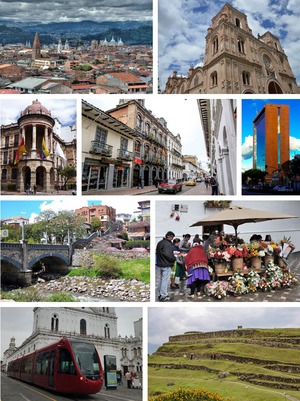
From top, left to right: Panoramic view of the Historic Center, Cathedral of the Immaculate Conception, City hall of Cuenca, Simon Bolívar Street, Cuenca Chamber of Commerce, Roto Bridge, Flowers Square, Cuenca Tram and archaeological ruins of Pumapungo.
|
|||
|
|||
| Nickname(s):
Atenas del Ecuador (Athens of Ecuador)
|
|||
| Country | |||
| Province | |||
| Canton | Cuenca Canton | ||
| Founded | April 12, 1557 | ||
| Founded by | Gil Ramírez Dávalos | ||
| Named for | Cuenca, Spain | ||
| Parishes |
Urban Parishes
Bellavista
Cañaribamba El Batán El Sagrario El Vecino Gil Ramírez Dávalos Hermano Miguel Huayna Cápac Machángara Monay San Blas San Sebastián Sucre Totoracocha Yanuncay |
||
| Area | |||
| • City | 3,195 km2 (1,234 sq mi) | ||
| • Urban | 71.45 km2 (27.59 sq mi) | ||
| • Canton | 3,195 km2 (1,234 sq mi) | ||
| Elevation | 2,560 m (8,400 ft) | ||
| Highest elevation | 2,550 m (8,370 ft) | ||
| Lowest elevation | 2,350 m (7,710 ft) | ||
| Population
(2022 census)
|
|||
| • City | 596,101 | ||
| • Density | 186.573/km2 (483.22/sq mi) | ||
| • Urban | 361,524 | ||
| • Urban density | 5,060/km2 (13,100/sq mi) | ||
| Demonym(s) | Cuencan | ||
| GDP (PPP, constant 2015 values) | |||
| • Year | 2023 | ||
| • Total | $6.5 billion | ||
| • Per capita | $14,600 | ||
| Time zone | UTC-5 (ECT) | ||
| Postal code |
EC010150
|
||
| Area code(s) | (+593) 07 | ||
| Climate | Marine | ||
| Website | Official website: http://www.cuenca.gob.ec/ | ||
Cuenca, officially called Santa Ana de los Ríos de Cuenca, is a major city in Ecuador. It is the capital of the Azuay province and its biggest city. Cuenca is special because four rivers flow through it: the Tomebamba, Tarqui, Yanuncay, and Machángara.
The city is located in the Andean mountains of Ecuador, about 2,538 meters (8,327 feet) above sea level. It has a mild, temperate climate, with an average temperature of about 16.3 °C (61.3 °F).
Cuenca is often called "Athens of Ecuador." This is because of its beautiful buildings, rich culture, and its important contributions to art, science, and literature in Ecuador. Many famous Ecuadorians were born here. In 2022, about 596,101 people lived in Cuenca, making it the third largest city in the country.
The city was founded on April 12, 1557. It was built on the ruins of an older Inca city called Tomebamba and a Cañari city named Guapondelig. A Spanish explorer named Gil Ramírez Dávalos founded it under orders from the viceroy of Peru. In 1999, the historic center of Cuenca was recognized as a UNESCO World Heritage Site because of its unique history and architecture. Today, Cuenca is a very important center for business, finance, and tourism in Ecuador.
Contents
What's in a Name? The Story of Cuenca's Name
The city's full name, Santa Ana de los Ríos de Cuenca, has a special meaning. It was named after the city of Cuenca in Spain. This was done to honor the Spanish viceroy of Peru, Andrés Hurtado de Mendoza, who was from that Spanish city. He was the one who ordered the founding of Cuenca in Ecuador. The area in Ecuador reminded the Spanish of the landscape in Cuenca, Spain.
The "de los Ríos" part of the name means "of the rivers." This is because the city is surrounded by four important rivers: the Tomebamba, Tarqui, Yanuncay, and Machángara. The first part, "Santa Ana," comes from the Spanish tradition of naming new cities after a saint from the Catholic Church, in this case, Saint Anne.
Cuenca's Long History
Cuenca has a very old history, going back thousands of years! Experts say that the first people lived here around 8060 BC. They were hunters who followed animals and seasons, using tools like arrows and spears.
Later, around 5585 BC, people started to settle down. They used the good climate and fertile land to grow crops like potatoes, squash, and quinoa. They also raised animals like guinea pigs and llamas.
Over time, these early people became more organized. They developed ways to manage water for farming and control pests. They also had special leaders for administration and religion, known as shamans.
Ancient Societies: Cañari and Inca
Before the Spanish arrived, Cuenca was home to the Cañari people. Their settlement was called Guapondeleg, which means "land as big as heaven." Archeologists believe it was founded around 500 AD.
About 50 years before the Spanish came, the Incas conquered the Cañari after a tough fight. The Incas took over Guapondeleg and renamed it Tomebamba. They built their own impressive buildings, but they also learned from the Cañari, especially their skills in astronomy and farming. Tomebamba became known as a second Cusco, which was the Inca capital.
The Inca emperor, Tupac Yupanqui, ordered the building of a magnificent city called Pumapungo, meaning "the door of the Puma." People said it was as grand as Cuzco itself, with stories of golden temples. However, by the time the Spanish arrived, Pumapungo was mostly in ruins. Some believe Tomebamba might have been the mythical city of gold, El Dorado, which was said to have been destroyed by its own people before the Spanish could find its treasures.
Spanish Arrival and Growth
The Spanish officially founded Cuenca on April 12, 1557. This was done by the explorer Gil Ramírez Dávalos. The city was named after the hometown of the Viceroy of Peru, Andrés Hurtado de Mendoza, 3rd Marquis of Cañete.
Cuenca grew steadily during the time of Spanish rule. It became even more important after Ecuador gained its independence on November 3, 1820. Cuenca became the capital of one of the three main regions of the new country, alongside Guayaquil and Quito.
People and Economy
Cuenca is a lively city with a growing population. In 2015, about 400,000 people lived in the city itself. Many people from other countries also choose to live here.
The city is well-known for its industries and farming. Cuenca is famous for making:
- Textiles: fabrics and clothes.
- Furniture: beautiful pieces for homes.
- Hats: especially the famous Panama hats, which are actually made by local artists in Cuenca!
- Shoes: high-quality footwear.
Cuenca also sends flowers to the United States and Europe. Farming is still important, with vegetables and corn being key crops. Raising cattle is another big part of the economy. Since Cuenca is in the Andes mountains, mining and logging are also local industries.
Tourism is also a huge part of Cuenca's economy. Many people visit to see its historic churches and the well-preserved old town, which is a UNESCO World Heritage Site. Nearby, you can also find amazing national parks like Cajas National Park.
Geography and Climate
Cuenca is located in the southern part of Ecuador's Andes mountains. It's about 470 kilometers (292 miles) south of Quito and 200 kilometers (124 miles) southeast of Guayaquil. The city sits at an elevation of about 2,350 to 2,550 meters (7,710 to 8,366 feet) above sea level.
The most important geographical features of Cuenca are its four rivers: the Tomebamba, Yanuncay, Tarqui, and Machangara. The first three rivers start in the Páramo (a type of high-altitude grassland) of Parque Nacional Cajas to the west of the city.
Cuenca's Weather
Cuenca has a mild climate all year round, which is typical for the Ecuadorian Andes. Days are usually warm, and nights are cool, so you might need a sweater or jacket. The average daily temperature is about 14.7 °C (58.5 °F).
There are two main seasons:
- Dry season: Generally from June to December.
- Rainy season: From January to May, with sunny mornings and afternoon showers. The heaviest rains usually happen in March, April, and May.
| Climate data for Cuenca, elevation 2,545 m (8,350 ft), (1981–2010 normals, extremes 2012–present) | |||||||||||||
|---|---|---|---|---|---|---|---|---|---|---|---|---|---|
| Month | Jan | Feb | Mar | Apr | May | Jun | Jul | Aug | Sep | Oct | Nov | Dec | Year |
| Record high °C (°F) | 29.3 (84.7) |
31.3 (88.3) |
29.1 (84.4) |
31.8 (89.2) |
32.0 (89.6) |
29.1 (84.4) |
29.5 (85.1) |
27.4 (81.3) |
31.3 (88.3) |
29.0 (84.2) |
28.7 (83.7) |
28.7 (83.7) |
32.0 (89.6) |
| Mean daily maximum °C (°F) | 22.0 (71.6) |
21.2 (70.2) |
21.4 (70.5) |
20.9 (69.6) |
20.9 (69.6) |
19.8 (67.6) |
18.6 (65.5) |
19.7 (67.5) |
20.3 (68.5) |
21.6 (70.9) |
22.2 (72.0) |
22.0 (71.6) |
20.9 (69.6) |
| Daily mean °C (°F) | 16.6 (61.9) |
16.3 (61.3) |
16.4 (61.5) |
16.2 (61.2) |
15.9 (60.6) |
14.9 (58.8) |
13.8 (56.8) |
14.6 (58.3) |
15.2 (59.4) |
16.2 (61.2) |
16.2 (61.2) |
16.6 (61.9) |
15.7 (60.3) |
| Mean daily minimum °C (°F) | 11.2 (52.2) |
11.4 (52.5) |
11.3 (52.3) |
11.4 (52.5) |
10.9 (51.6) |
10.0 (50.0) |
9.0 (48.2) |
9.5 (49.1) |
10.1 (50.2) |
10.7 (51.3) |
10.2 (50.4) |
11.1 (52.0) |
10.6 (51.0) |
| Record low °C (°F) | 3.7 (38.7) |
5.6 (42.1) |
5.8 (42.4) |
3.3 (37.9) |
5.1 (41.2) |
4.8 (40.6) |
3.2 (37.8) |
2.7 (36.9) |
3.7 (38.7) |
4.4 (39.9) |
0.5 (32.9) |
1.8 (35.2) |
0.5 (32.9) |
| Average precipitation mm (inches) | 58.1 (2.29) |
85.4 (3.36) |
112.8 (4.44) |
123.3 (4.85) |
85.5 (3.37) |
46.9 (1.85) |
27.9 (1.10) |
19.8 (0.78) |
49.7 (1.96) |
90.8 (3.57) |
86.2 (3.39) |
89.8 (3.54) |
876.2 (34.5) |
| Mean monthly sunshine hours | 155 | 113 | 124 | 120 | 155 | 150 | 186 | 186 | 150 | 155 | 150 | 155 | 1,799 |
| Source 1: World Meteorological Organization | |||||||||||||
| Source 2: Meteomanz Cuenca Climate Guide | |||||||||||||
Education in Cuenca
Cuenca is known as the "City of Universities" in Ecuador. The first university, the Universidad de Cuenca, was founded in 1867. It's one of the oldest universities in the country. Over time, more universities were created, offering many different study programs.
Here are some of the universities in Cuenca:
- Universidad de Cuenca (UCUENCA)
- Universidad Politécnica Salesiana (UPS)
- Universidad del Azuay (UDA)
- Universidad Católica de Cuenca (UCACUE)
Cuenca also has international schools, like the French school (École Franco-équatorienne Joseph-de-Jussieu) and the German school (Colegio Alemán Stiehle).
Main Sights to See
| UNESCO World Heritage Site | |
|---|---|
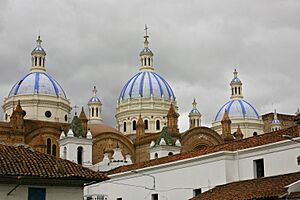
The Catedral Nueva
|
|
| Criteria | Cultural: ii, iv, v |
| Inscription | 1999 (23rd Session) |
| Area | 224.14 ha |
| Buffer zone | 1,836.94 ha |
Most visitors love exploring Cuenca's historic center, which is a UNESCO World Heritage Site. It's easy to walk around because of its grid-like street plan and many famous buildings.
Cuenca celebrates several big festivals. One is the "Mass of Children" on January 6th, which is Epiphany Day. Another major celebration is on November 3rd, marking the city's independence. During these times, you can see parades, cultural shows, and dances.
Famous Landmarks
- Old Cathedral (Iglesia de El Sagrario): Built in 1557, this church eventually became too small. It's now a museum after being restored.
- New Cathedral (Catedral Metropolitana de la Inmaculada Concepción): This huge cathedral, finished in 1975, has beautiful blue and white domes that are a symbol of Cuenca. Its front is made of alabaster and marble, and the floor inside is pink marble from Italy.
- Park Abdon Calderon: This peaceful park is right in the center of Cuenca, between the old and new cathedrals. It's a great place to relax.
- Monastery of El Carmen de Asuncion: Founded in 1682, this church has a lovely flower market in its entrance area. Inside, you'll find a carved stone front and a golden pulpit.
- Monastery and Museum of La Concepcion: Here you can see tombs from the 1600s and a large collection of religious art.
- Ruinas de todos los santos: These ancient ruins show four stone niches built by the Incas. There are also remains of an old colonial mill.
- Turi the Mirador: This viewpoint offers amazing panoramic views of the entire city of Cuenca.
Exploring Around Cuenca
- Molleturo: This large rural area in the Andes has many small villages. It's known for its beautiful natural landscapes.
- Jima: Located near Cuenca, Jima is a popular spot for hiking. You can find trails for all skill levels, including longer hikes that go from the Andes mountains down into the Amazon rainforest.
- Chordeleg: Less than 50 kilometers (31 miles) from Cuenca, Chordeleg is a town famous for its skilled weavers, embroiderers, and potters. It's also known for gold and silver jewelry.
- El Cajas: This national park is full of rivers, streams, and lagoons, with altitudes ranging from 3,500 to 4,200 meters (11,483 to 13,780 feet) above sea level. It's a fantastic place for bird watchers and trout fishermen.
- Azogues: The capital of Cañar Province, Azogues is about 29 kilometers (18 miles) from Cuenca. It has a colonial feel, and one of its highlights is the San Francisco convent, built on a sacred pre-Hispanic mountain.
- Ingapirca: About 65 kilometers (40 miles) from Cuenca, these are the largest Inca ruins in Ecuador. Built in the 15th century, they include stores, bathrooms, and a temple dedicated to the sun.
Culture and Food
Festivities
One of the most fun holidays in Cuenca is "El Carnaval." This celebration happens three days before Ash Wednesday. Families get together, and people playfully spray each other with water balloons and foam called "Carioca."
Cuenca's Independence Day is celebrated in early November. The festivities last for several days, with parades, concerts, cultural events, and craft fairs.
Delicious Food
Cuenca's food is similar to other mountain regions in Ecuador. Some popular traditional dishes include:
- Cuy: (guinea pig) a traditional meat dish.
- Hornado: roasted pork.
- Mote: dishes made from corn, like mote pillo (corn with eggs and cheese) and mote pata (a soup with corn and pork).
- Llapingachos: potato pancakes.
- Trout: fresh fish caught from nearby places like El Cajas National Park.
In Cuenca, lunch is usually the biggest meal of the day. It often starts with a soup, followed by a main dish of stewed or grilled meat with rice.
Getting Around Cuenca
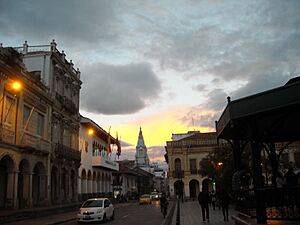
Bus Station
Cuenca's main bus station, called the Terminal Terrestre, is very organized and clean. It's located in the northeastern part of the city, about a 20-minute walk or short taxi ride from the historic center. City buses also go to the terminal.
You can take buses from Cuenca to major cities like Guayaquil and Quito, as well as nearby cities like Loja. The trip to Guayaquil takes about 4 hours, and the ride through Cajas National Park is very scenic. Traveling to Quito takes around 10 hours.
Airport
The airport, Mariscal Lamar International Airport, is just east of the bus station. You can walk there in about five minutes. Two airlines, Avianca Ecuador and LATAM Ecuador, offer flights to Quito. It's Ecuador's third busiest airport.
Tram System
Cuenca has a modern tram (light rail) line that opened in May 2020. The line is about 10.5 kilometers (7 miles) long and has 27 stations. It runs from the Industrial Park in the north, through the Historic Center, and ends near Baños in the south.
Public Transportation Facts
Public transport in Cuenca is very efficient. On average, people spend about 51 minutes commuting on public transit on a weekday. Most riders wait about 11 minutes at a bus stop. The average distance people travel in one trip is about 3.8 kilometers (2.4 miles). In 2018, a regular bus fare was 30 US cents, with lower fares for children, students, seniors, and people with disabilities.
Cuenca's Global Connections
Cuenca has special relationships with other cities around the world, called "twin towns" or "sister cities." These connections help promote cultural exchange and friendship.
Cuenca is twinned with:
 Rosario, Argentina
Rosario, Argentina Tempe, Arizona, United States
Tempe, Arizona, United States Ossining, New York, United States
Ossining, New York, United States
See also
 In Spanish: Cuenca (Ecuador) para niños
In Spanish: Cuenca (Ecuador) para niños




